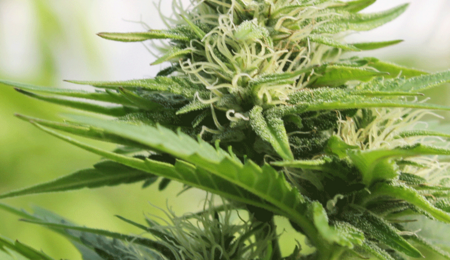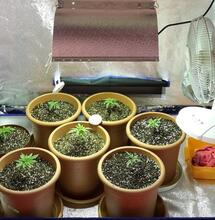Organic vs. Synthetic, Side-by-Side

There are some differences of opinion that are argued over more that others, and a common topic for debate is the difference between organic and synthetic nutrients. The amount of conflicting information available on the topic is staggering. I have heard both sides of the fence hurl claims and insults at each other, with vehemence and determination.
There are some differences of opinion that are argued over more that others, and a common topic for debate is the difference between organic and synthetic nutrients. The amount of conflicting information available on the topic is staggering. I have heard both sides of the fence hurl claims and insults at each other, with vehemence and determination.
Gentle reader, I thought I'd take a few plants, and a few nutrients, and see what I could find out for myself on the topic. I tried three drip/DWC hybrid systems, three clones and three sets of nutrients, to see what I could see. I'm not claiming this is the definitive test on the topic, I'm just reporting what happened with three particular plants.
The three plants were all taken from the same mother, a Purple Lady from G13, and started indoors under a 1000-watt, metal halide lamp. One was fed a prepared line of organic nutrients; one was fed on traditional organic nutrients, including bone meal, blood meal, alfalfa meal, guano, kelp and potash; the last was fed a line of synthetic nutrients.The traditional organic plant suffered from gardener error and was mistakenly overdosed with potassium (K) in early growth, stunting it. The commercial organic plant grew well and did not show indications of nutrient deficiencies, but appeared to be a fair amount smaller and busier than the commercial, synthetic-fed plant.
At four weeks from seed they were moved outside, for two reasons. One, so the long nights of autumn would trigger flowering, and two, because that was when my 1000-watt digital ballast died. The natural lighting in the area I had available to use was not ideal, but some light is better than none at all, and the same goes for yield.
During flowering the plants looked very similar, with no noteworthy differences in bud structure appearance between the three. The 'synthetic' plant continued to enjoy a lead in size throughout the grow.
At harvest, root development was best with the synthetically-fed plant, with a final harvest of 71 g dry smoke. The two organic plants came in well behind, with 32 g for the commercial line and 24 g for the traditional organic plant.A double-blind panel of ten was used to taste test the results. Only after all the comments and rankings were documented were the identities revealed. Since my 'poker face' isn't the best, I thought it prudent if I didn't know the identities of each of the samples, so I wouldn't influence the panel in their responses. I hid the true identity of each of the three in the lids of a set of three matched jars. The jars were mixed, shuffled, randomized, and otherwise spun about so that I had no idea which was which. Then each was assigned a label, 'Thing 1', 'Thing 2' or 'Thing 3'. Joints rolled from Thing 1 had one stripe, Thing 2 joints had two stripes, and Thing 3, three. When panel members responded, they addressed their remarks only by 'Thing' and the number, since the true identities of each was hidden.
Here are the results:
In third place, with seven points: Organic (Traditional)
I thought it was the smoothest of the three. It was more like using a vaporizer than smoking a joint. On the down side, it shared the same drawback, in that it is almost too smooth to feel fulfilling. Comments from the panel also remarked on the mildness, although not always as kindly, with one respondent calling it “bland” and other remarks such as, “No fruit nor floral fragrance. No fruit flavor. I missed the fruit and floral notes in this one.” Also, “Had a very smooth taste, like an ultralight cigarette. Hard to tell for sure that you got a hit until you exhale.”
I believe that the comparatively lighter nutrient regimen allowed for a cleaner flavor. However, the low ranking may be a reflection that too light and clean of a flavor may not be the most popular.
In second place, with 11 points: Organic (General Organics GO Box)
This was my favorite, and only a single point separated second place from first in the flavor rankings. I thought it was the most floral tasting of the three. Panel members agreed with comments such as, “Fresh-cut florals! Fresh berries and citrus!” and, “The scent and taste is both woody and floral, with a light, berry/citrus fruit scent and pineapple-mango taste on the top notes.” Also, “has layers of flavor, and it's easy to detect the florals, the fruit and the woody earthiness. This is my favorite of the three.” The highest praise came from a respondent who wrote, “Liked the mildness and gentleness to Things 3 and 2. Didn't feel like coughing at all. Wrote a little poem afterward:
“Thing 1 is done, Thing 2 is through, Thing 3 is free Hooray for me!”In first place, with 12 points: Synthetic (General Hydroponics Flora Series)
When I tried it, I found it to be both smooth and pleasant, with a mild fruity flavor on the tip of the tongue upon exhalation. Panel members remarked that it was “detectably fruity on the inhale, smooth and no harshness on the throat,” with a “berry-fruit-light citrus taste and scent.” The “strong grape notes” were said to have “a stronger taste, more substantial and satisfying.”I was pretty surprised at the result. I had been led to believe that the Cannabis grown with organic nutrients would taste substantially better than the one grown with synthetics. There was a noticeable difference between the two: the synthetic tasted fruitier, and the organic tasted more floral, but the answers as to which tasted 'better' was almost split down the middle, with only a single point between them. Apparently, personal preference plays a key part.
A single test with a couple of plants isn't a very large sample, so this may be an exception and not representative of normal results. However, each time things are tested, and each time results are reported upon, the body of knowledge that we all share gets just a little bit bigger.
Peace, love and puka shells, Grubbycup



